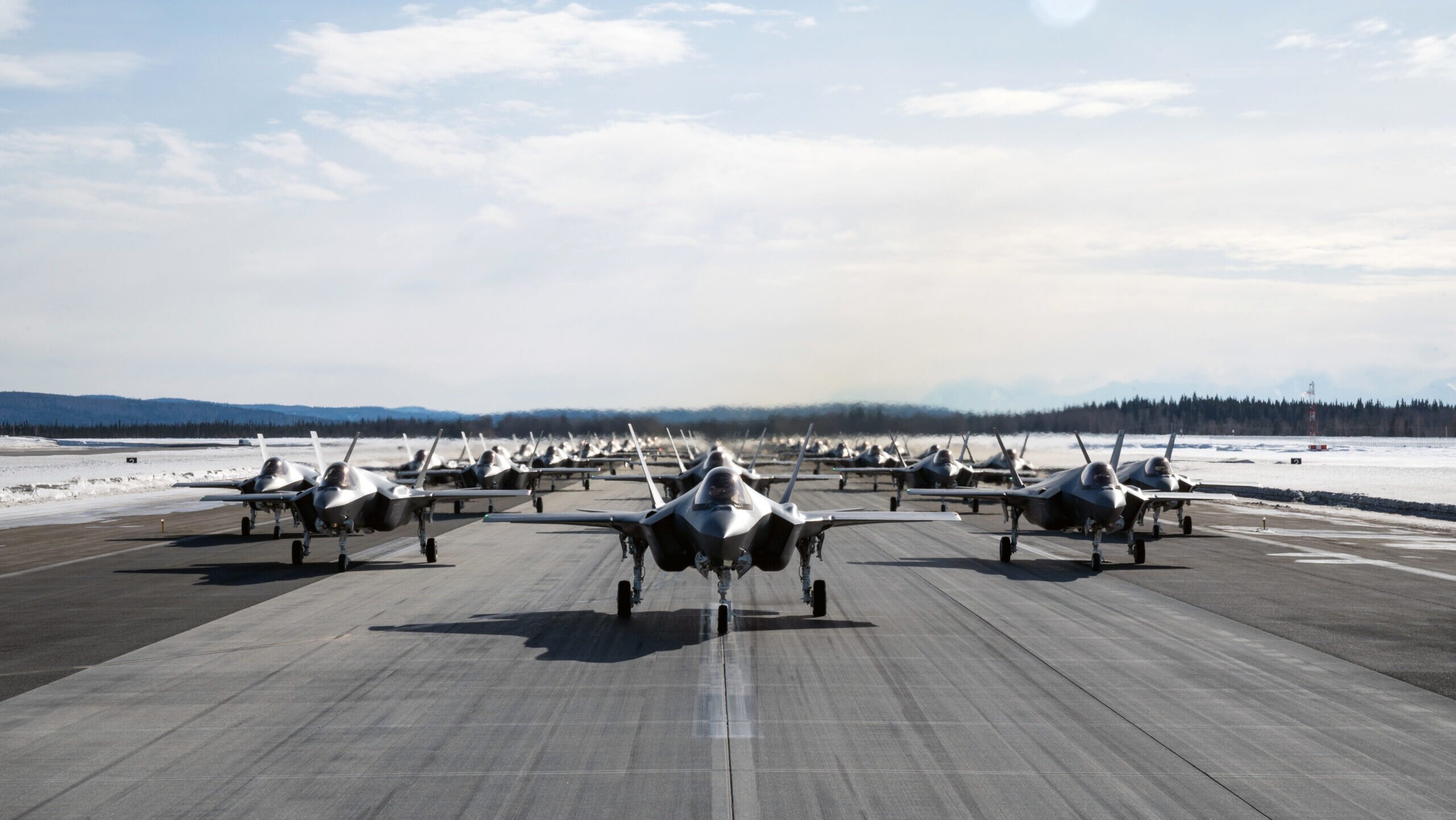
A formation of 42 F-35A Lightning II’s, 354th Fighter Wing, during a routine readiness exercise at Eielson Air Force Base, Alaska, March 25, 2022. (U.S. Air Force photo by Airman 1st Class Jose Miguel T. Tamondong)
WASHINGTON — Congressional auditors revealed today the total price tag for the Lockheed Martin F-35, the world’s most expensive weapons program, has topped $2 trillion — surpassing a previous estimate of $1.7 trillion.
That increase, according to a new Government Accountability Office (GAO) report, was driven in part by sustainment costs stemming from the Pentagon’s decision to operate the jet through 2088, over a decade longer than a previously planned target of 2077. The new sustainment outlook of $1.58 trillion over the program’s lifecycle also captures other adjustments like inflation and aircraft use, the report says.
Combined with an estimated procurement cost of $422 billion, the program’s total expected cost is now over $2 trillion, an eye-popping figure for a fleet that is currently falling short of mission capable goals.
“DOD has explored a few options to manage F-35 sustainment more efficiently; however, it is unclear how any potential changes would affect sustainment costs,” the GAO report said.
The increasing sustainment outlook comes even as the military services scale back their planned flight hours of the tri-variant stealth fighter, which officials told GAO is one of the “only” ways to secure “significant” cost savings for the program that has long struggled to arrest a rising topline. Specifically, the Air Force, Marine Corps and Navy all lowered their estimated outlook of how many hours a year their jets would fly at “steady state” — a status GAO said the fleet would achieve in “roughly the mid-2030s for each of the services” — contributing to a collective 21 percent reduction in annual flight hours.
Only C variant stealth fighters flown by the Marine Corps are expected to fly more hours than previously anticipated, with all those in use by the other services, including the Navy’s F-35C, flying fewer hours than prior estimates. However, the military services can continue to revise fleet plans annually. Military officials told GAO that the “reduction in planned flight hours reflects lower than anticipated use up to this point and evolving projections about future use of the aircraft,” the report says.
Those flight hour reductions helped the military services all meet their annual affordability targets for operating the aircraft at steady state, with the exception of the small fleet of the Marine Corps F-35C. The Air Force’s 2023 upward revision of its affordability threshold for annual operations from $4.1 million to $6.8 million per tail also ensured the current estimate of $6.6 million would remain within bounds. The GAO noted the Marine Corps and Navy must similarly revise their affordability threshholds by October 2025.
The $2 trillion pricetag is hardly set, however, and other factors still could affect sustainment costs down the road. For example, DoD officials told GAO that only approved upgrades, such as the ongoing Block 4 modernization, are factored into current cost projections, though officials have discussed future upgrades like a Block 5 effort. And, according to GAO, “the program does not generally consider risk and uncertainty in its sustainment estimate for the program.” Generally, the cost estimate is also something of an informed guess, given how much contributing factors could vary in years to come.
RELATED: ‘Campaign of learning’: 6 questions about the F-35 with a lead DoD sustainment official
In a statement, F-35 Joint Program Office (JPO) spokesman Russ Goemaere said, “We have continued to reduce Sustainment costs through growth and maturation of the F-35 Enterprise including JPO Product Support Manager (PSM) efforts to drive down contract costs; better alignment of US Services requirements and budgets; and an active cost reduction initiative pipeline; resulting in 34% improvement in the DoD F-35 Cost per Tail per Year (CPTPY) between 2014-22 from $9.4M to $6.2M and a 61% improvement in the DoD F-35 Cost per Flying Hour (CPFH) between 2014-22, from $86.8K to $33.6K, all in Constant Year 2012 [dollars].”
After publication of this report, Lockheed Martin said in a statement that “[w]e stand ready to partner with the government as further sustainment plans are created to maintain mission readiness and deterrence for the F-35, now and through its extended service life of 2088.”
A decade of work by the JPO has helped achieve approximately $84 billion in savings over the program’s lifespan, officials told GAO. But those officials fretted that only reducing planned procurement or slashing flight hours can amount to more significant savings.
In a sweeping report on F-35 sustainment in September 2023, GAO found that the Pentagon was heavily reliant on prime contractor Lockheed for sustainment, which is further complicated by the aerospace giant’s and its suppliers’ ownership of critical technical data. F-35 program officials plan to address contractor roles and technical data ownership through the congressionally mandated transfer of sustainment functions to the military services by October 2027, today’s report says.
DoD further explored the possibility of a performance-based logistics contract as another tool to either yield cost savings or increase the fleet’s readiness, but difficulties in certifying either criteria led the Pentagon to pause those negotiations with Lockheed, Breaking Defense previously reported.
The cloudy sustainment picture comes as the F-35 program is failing to meet mission capable rate goals, which GAO covered in the September 2023 sustainment report. The program is meeting 17 of 24 reliability and maintainability goals as of August 2023, GAO found today, but woes ranging from depot capacity to a dearth of spare parts continue to drag down fleet readiness. Still, the program has managed to eke out some relatively good news in recent months, the most recent being the mostly symbolic move to approve the jet’s full rate production after years of delays.
In total, GAO said DoD has implemented just 13 of 43 recommendations the watchdog has made since 2014 on operating and sustaining the F-35. Lawmakers plan to further probe the program’s performance in a hearing the House Armed Services tactical air and land forces subcommittee is scheduled to hold Tuesday.
UPDATED 4/15/24 at 5:38 PM ET with comment from Lockheed Martin.
Australia tops up Ukraine military aid with $100M
Australia has already supplied Ukraine with 120 Bushmaster vehicles, six 155mm howitzers, 56 M113 armored vehicles, 14 special operations vehicles and its signature cardboard drones.



























